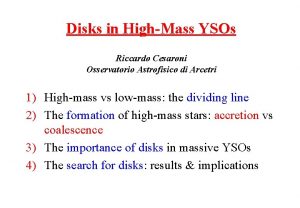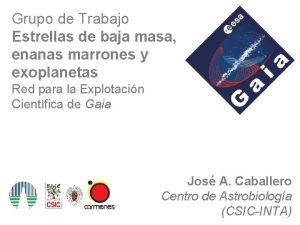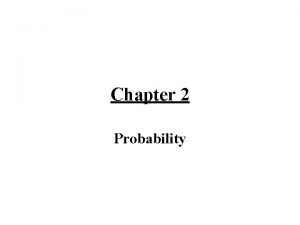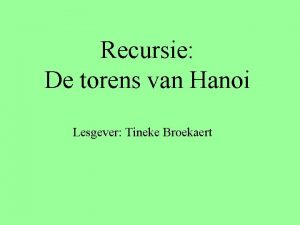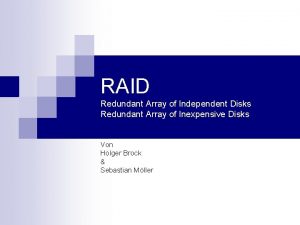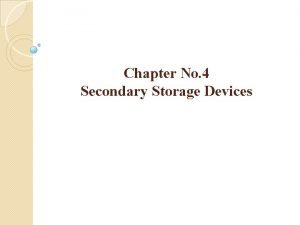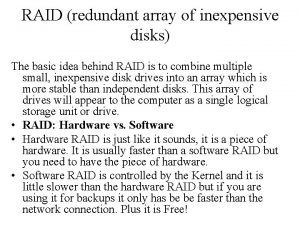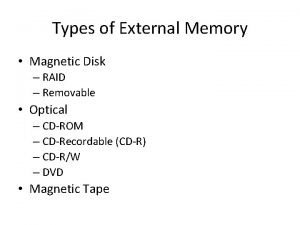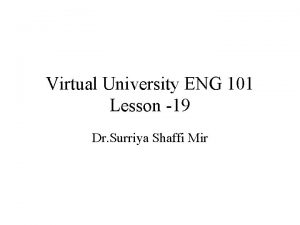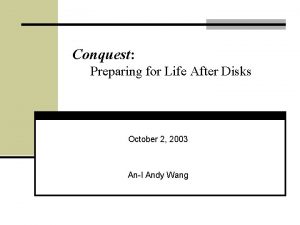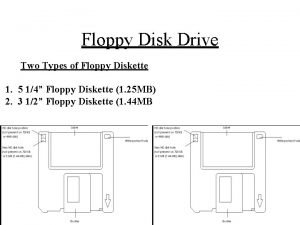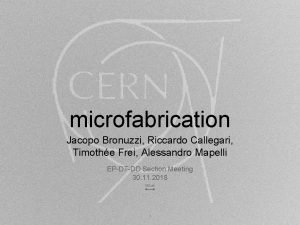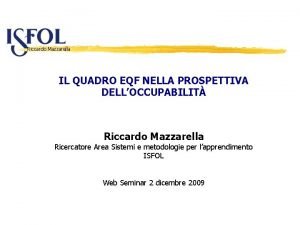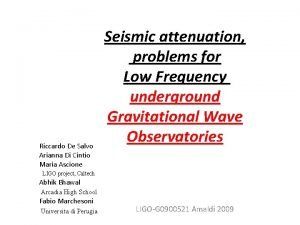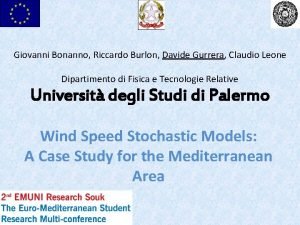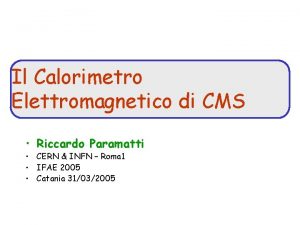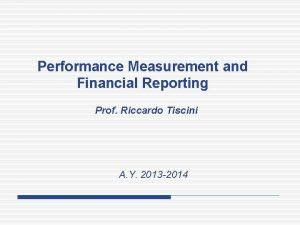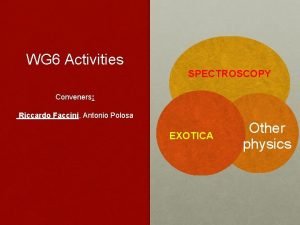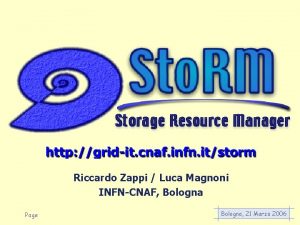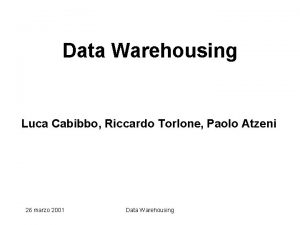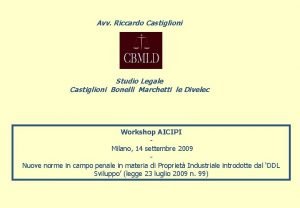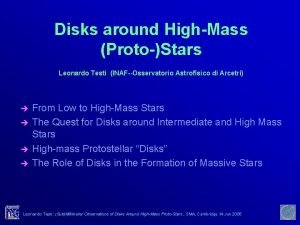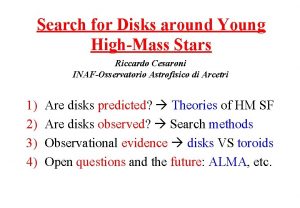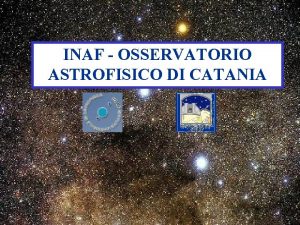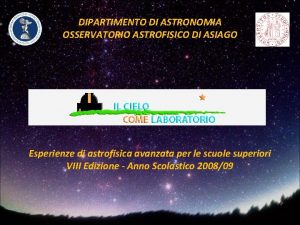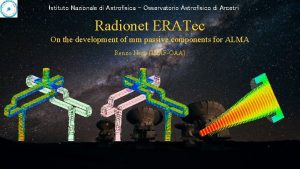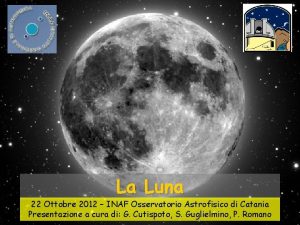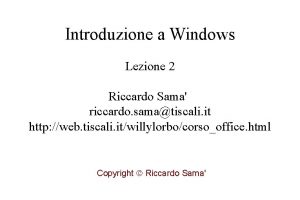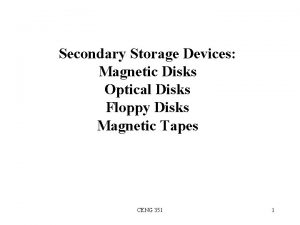Disks in HighMass YSOs Riccardo Cesaroni Osservatorio Astrofisico


















































- Slides: 50

Disks in High-Mass YSOs Riccardo Cesaroni Osservatorio Astrofisico di Arcetri 1) High-mass vs low-mass: the dividing line 2) The formation of high-mass stars: accretion vs coalescence 3) The importance of disks in massive YSOs 4) The search for disks: results & implications

Low-mass vs High-mass Theory (Shu et al. 1987): star formation from inside-out collapse onto protostar Two relevant timescales: accretion tacc = M*/(d. M/dt) contraction t. KH = GM*/R*L* Ø Low mass (< 8 MO): tacc < t. KH Ø High mass (> 8 MO): tacc > t. KH accretion on ZAMS (Palla & Stahler 1993)

PROBLEM: High-mass stars “switch on” still accreting radiation pressure stops accretion stars > 8 MO cannot form!? SOLUTIONS Yorke (2003): Kdust< Kcrit M*/L* 1) “Increase’’ M*/L*: non-spherical accretion 2) Reduce Kdust: large grains (or coalescence of lower mass stars)

Possible models • (Non-spherical) accretion: Behrend & Maeder (2001); Yorke & Sonnhalter (2002); Tan & Mc. Kee (2003) ram pressure > radiation pressure • Coalescence: Bonnell et al. (1998, 2004) many low-mass stars merge into one massive star

Infall + angular momentum conservation rotating disks: “only’’ in accretion model discriminant between models: rotation of molecular cores

High-mass star forming regions: Observations • Observational problems: § § § IMF high-mass stars are rare large distance: >300 pc, typically a few kpc formation in clusters confusion rapid evolution: tacc=20 MO /10 -3 MOyr-1=2 104 yr parental environment profoundly altered • Advantage: § very luminous (cont. & line) and rich (molecules)!

High-mass star forming region disk? 0. 5 pc

The evidence for disks in massive YSOs • Large scale (1 pc) rotating clumps seen e. g. in NH 3 (G 35. 2 -0. 74; Little et al. 1985), CO (IRAS 07427; Kumar et al. 2003) • Small scale (<0. 1 pc) many claims of rotating “disks’’…

The evidence for disks in massive YSOs • Large scale (1 pc) rotating clumps seen e. g. in NH 3 (G 35. 2 -0. 74; Little et al. 1985), CO (IRAS 07427; Kumar et al. 2003) • Small scale (<0. 1 pc) many claims of rotating “disks’’…

CH 3 OH masers Si. O & H 2 O masers NIR, mm & cm continuum ATCA, Ellingsen et al. , Walsh et al. EVN Minier et al. , Edris et al. , Pestalozzi et al. Merlin outflow sources: Cohen et al. , Edris et al. VLA, e. g. Orion source I VLBA Greenhill, Torrelles et al. BIMA, jets/outflows in massive stars VLA Hoare et al. , Gibb et al. NH 3, C 18 O, CS, Pd. BI, UC HIIs, Hot Cores C 34 S, CH 3 CN, … OVRO, Keto et al. , Cesaroni et al. , BIMA, Zhang et al. , etc…. NMA

• CH 3 OH masers: stellar mass too low; H 2 jets parallel to CH 3 OH spots (De Buizer 2003) • OH masers: very few examples • Si. O & H 2 O masers: outflow and/or disk • NIR-cm cont. : confusion between disk and wind emission • Molecular lines: kinematical signature of disk & outflow

CH 3 OH masers NGC 7538 Pestalozzi et al. (2004) 6 GHz M*=30 MO ? ? ?

• CH 3 OH masers: stellar mass too low; H 2 jets parallel to CH 3 OH spots (De Buizer 2003) • OH masers: very few examples • Si. O & H 2 O masers: outflow and/or disk • NIR-cm cont. : confusion between disk and wind emission • Molecular lines: kinematical signature of disk & outflow

OH masers IRAS 20126+4104 NIR & OH masers Edris et al. (subm. ) disk

• CH 3 OH masers: stellar mass too low; H 2 jets parallel to CH 3 OH spots (De Buizer 2003) • OH masers: very few examples • Si. O & H 2 O masers: outflow and/or disk • NIR-cm cont. : confusion between disk and wind emission • Molecular lines: kinematical signature of disk & outflow

H 2 O masers Cep A HW 2 Torrelles et al. (1996)

• CH 3 OH masers: stellar mass too low; H 2 jets parallel to CH 3 OH spots (De Buizer 2003) • Si. O & H 2 O masers: outflow or disk? • NIR-cm cont. : confusion between disk and wind emission? • Molecular lines: kinematical signature of rotation & outflow core disk outflow

G 192. 16 -3. 82 Shepherd & Kurtz (1999) 2. 6 mm cont. disk CO outflow

G 192. 16 -3. 82 Shepherd & Kurtz (1999) Shepherd et al. (2002) 3. 6 cm cont. & H 2 O masers

IRAS 20126+4104 M*=7 et Mal. ; O Moscadelli et al. Cesaroni H 2 O masers prop. motions

NGC 7538 S Sandell et al. (2003) HCN(1 -0)

M 17 0. 01 pc Chini et al. (2004) 2. 2 micron 13 CO(1 -0) 0. 07 pc

Disks & Toroids O stars M* (MO) 7 6 -10 15 -20 40? 20… - B stars L Mdisk Ddisk (LO) (MO) (AU) IRAS 20126 104 4 1600 G 192. 16 3 103 15 1000 M 17 ? >110 20000 NGC 7538 S 104 100 -400 30000 G 24. 78 (3) 7 105 80 -250 4000 -8000 G 29. 96 9 104 300 14000 G 31. 41 3 105 490 16000

Gibb et al. (2002) Olmi et al. (2003) Olmi et al. (1996) Furuya et al. (2002) Beltran et al. (2004)

Furuya et al. (2002) Beltran et al. (2004)

Furuya et al. (2002) Beltran et al. (2004)

Furuya et al. (2002) Beltran et al. (2004)

CH 3 CN(12 -11) Gibb et al. (2002) Olmi et al. (2003) Beltran et al. (2005)

Olmi et al. (1996) Beltran et al. (2004) 1200 AU

Beltran et al. (in prep. ) Temperature

Disks & Toroids O stars M* (MO) 7 6 -10 15 -20 40 20… - B stars L Mdisk Ddisk (LO) (MO) (AU) IRAS 20126 104 4 1600 G 192. 16 3 103 15 1000 M 17 ? >110 20000 NGC 7538 S 104 100 -400 30000 G 24. 78 (3) 7 105 80 -250 4000 -8000 G 29. 96 9 104 300 14000 G 31. 41 3 105 490 16000

12 CO(1 -0) & 3 mm continuum Furuya et al. (in prep. ) VCH 3 CN(km/s)

Results • “Circumcluster’’ (massive) toroids in O (proto)stars • Circumstellar (Keplerian) disks in early-B (proto)stars Are disks in O (proto)stars short lived?

Disk life time Assuming (d. M/dt)acc (d. M/dt)outflow and Mdisk M*

Conclusions • Circumstellar (Keplerian) disks in early-B (proto)stars disk accretion likely • Circumcluster (unstable) toroids in O (proto)stars large accretion rates make them long-lived ACCRETION SCENARIO MORE LIKELY

http: //www. arcetri. astro. it/iaus 227

END

The case of G 31. 41+0. 31 • • “Pseudo” toroidal structure in CH 3 CN T increase towards center embedded YSO(s) Vrot not Keplerian (const. or increasing with R) Evidence for infall: – Mdyn << Mtoroid – line FWHM increasing towards centre

Beltran et al. (in prep. ) 1200 AU Hofner pers. comm.

The case of G 31. 41+0. 31 • • “Pseudo” toroidal structure in CH 3 CN T increase towards center embedded YSO(s) Vrot const. or increasing with R Evidence for infall: – Mdyn << Mtoroid – line FWHM increasing towards centre

Beltran et al. (in prep. ) Temperature

Beltran et al. (in prep. ) Column density

The case of G 31. 41+0. 31 • • “Pseudo” toroidal structure in CH 3 CN T increase towards center embedded YSO(s) Vrot const. or increasing with R Evidence for infall: – Mdyn << Mtoroid – line FWHM increasing towards centre

V=const. Beltran et al. (in prep. ) P-V plots along disk plane Ω=const.

The case of G 31. 41+0. 31 • • “Pseudo” toroidal structure in CH 3 CN T increase towards center embedded YSO(s) Vrot const. or increasing with R Evidence for infall: – Mdyn << Mtoroid – line FWHM increasing towards centre

Beltran et al. (in prep. ) line FWHM

A different viewpoint… Gibb et al. (2004) observed 2 “toroids” in C 18 O & H 2 S, with 1” resol. opposite interpretation: H 2 S and CH 3 CN from outflow, C 18 O from disk We need reliable outflow tracer! 12 CO Recent observations of 12 CO & CH 3 CN in other high mass YSOs (Furuya et al. in prep. ) seem to confirm that CH 3 CN traces rotation. Whatever the interpretation, there is common agreement that cores are rotating!

A different viewpoint… Gibb et al. (2004) observed 2 “toroids” in C 18 O & H 2 S, with 1” resol. opposite interpretation: H 2 S and CH 3 CN from outflow, C 18 O from disk We need reliable outflow tracer! 12 CO Recent observations of 12 CO & CH 3 CN in other high mass YSOs (Furuya et al. in prep. ) seem to confirm that CH 3 CN traces rotation. Whatever the interpretation, there is common agreement that cores are rotating!


CH 3 OH masers W 48 Minier et al. (2000) 6 GHz M*=6 MO
 Mass8mo
Mass8mo Jose antonio caballero astrofisico
Jose antonio caballero astrofisico Osservatorio edile biella
Osservatorio edile biella Probability learning objectives
Probability learning objectives Tower of hanoi 4 disks
Tower of hanoi 4 disks Holger brock
Holger brock What are magnetic storage devices
What are magnetic storage devices Azure vm ssd
Azure vm ssd Redundant array of inexpensive disks
Redundant array of inexpensive disks Types of external memory
Types of external memory Disks and tapes can be stored ------- a library. eng101
Disks and tapes can be stored ------- a library. eng101 Conquest data disks
Conquest data disks A mechanism that spins reads and writes disks
A mechanism that spins reads and writes disks Redundancy array of independent disk
Redundancy array of independent disk Raid 5 nedir
Raid 5 nedir Floppy disk
Floppy disk Description
Description Riccardo callegari
Riccardo callegari Riccardo mazzarella
Riccardo mazzarella Riccardo corgiat mecio
Riccardo corgiat mecio Fernando pavarotti
Fernando pavarotti Riccardo cioffi
Riccardo cioffi Riccardo ascione
Riccardo ascione Riccardo benussi
Riccardo benussi Excludeproc.a
Excludeproc.a Riccardo marangon
Riccardo marangon Dott riccardo simoni
Dott riccardo simoni Riccardo burlon
Riccardo burlon Riccardo puglisi moglie
Riccardo puglisi moglie Riccardo dominici
Riccardo dominici Riccardo puglisi
Riccardo puglisi Riccardo tiscini
Riccardo tiscini Riccardo sartori psicologo
Riccardo sartori psicologo Riccardo paramatti
Riccardo paramatti Riccardo tiscini
Riccardo tiscini De lisa unica
De lisa unica Riccardo polastro
Riccardo polastro Riccardo desalvo
Riccardo desalvo Riccardo faccini
Riccardo faccini Riccardo tiscini
Riccardo tiscini Riccardo magnoni
Riccardo magnoni Riccardo torlone
Riccardo torlone Riccardo gagliarducci
Riccardo gagliarducci Riccardo castiglioni
Riccardo castiglioni
